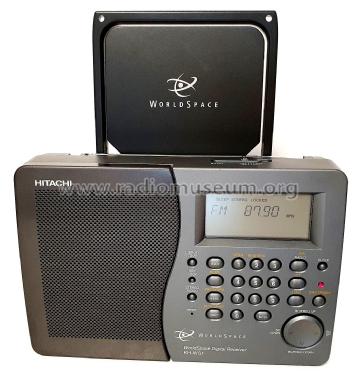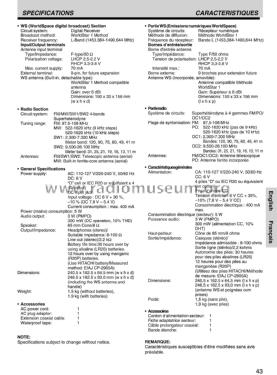World Space Digital Satellit-Receiver KH-WS1
Hitachi Ltd.; Tokyo
- Country
- Japan
- Manufacturer / Brand
- Hitachi Ltd.; Tokyo
- Year
- 1999 ?

- Category
- Broadcast Receiver - or past WW2 Tuner
- Radiomuseum.org ID
- 158713
-
- alternative name: Hitachi Sales Corp. of America
- Number of Transistors
- Semiconductors present.
- Semiconductors
- Main principle
- Superheterodyne (common)
- Wave bands
- Wave Bands given in the notes.
- Power type and voltage
- Line / Batteries (any type) / 110-127; 220-240; 6 Volt
- Loudspeaker
- Permanent Magnet Dynamic (PDyn) Loudspeaker (moving coil)
- Power out
- 3 W (unknown quality)
- Material
- Plastics (no bakelite or catalin)
- from Radiomuseum.org
- Model: World Space Digital Satellit-Receiver KH-WS1 - Hitachi Ltd.; Tokyo
- Shape
- Portable set > 8 inch (also usable without mains)
- Dimensions (WHD)
- 241 x 163 x 65 mm / 9.5 x 6.4 x 2.6 inch
- Notes
-
Frequenzbereiche
Worldspace L-Band: 1453,384-1490,644 MHz
UKW: 87,5-108,00 MHz
SW1: 2,300-7,300 MHz
SW2: 9,500-26,100 MHz
MW: 520-1620 kHz
Modulationsarten: Worldstar 1 method (QPSK); FM; AM
Speicherplätze: 10 für World Space,je 10 für Mittelwelle und UKW; je 5 für SW1 und SW2
Stereo Empfang, TeleskopantenneWikipedia schreibt unter dem Begriff Worldspace:
WorldSpace ist ein gescheitertes digitales Satellitenradionetzwerk. Es versorgte Afrika ganzflächig und darüber hinaus Teile Asiens und Europas. Es bestand aus zwei Satelliten, AfriStar und AsiaStar. Es standen pro Satellit 50 Kanäle zur Verfügung, die für digitale Radioprogramme, aber auch Multimediadienste genutzt werden konnten. 2008 beantragte Worldspace Insolvenz.Ein Radio-Set besteht aus einem portablen Satellitenempfänger und einer handtellergroßen Satellitenantenne, wobei diese auf eine der beiden Satelliten AfriStar und AsiaStar ausgerichtet werden musste.
Wikipedia writes under 1worldspace:
1worldspace, known for most of its existence simply as 'WorldSpace', is a defunct satellite radio network.
Before filing for bankruptcy in October 2008, 1worldspace employed two satellites and broadcast 62 channels.Users purchased receivers compatible with the L-Band frequency in order to access the system. The radio receiver processed, decoded and descrambled the signals to allow users to receive programming content. The company’s broadcast frequency and satellites required a special receiver design incorporating either a small patch antenna measuring approximately 6 to 8 cm (2.4 to 3.2 inches) which folded neatly into the receiver unit or a similarly sized omni-directional antenna mounted on the car rooftop. Each receiver was individually addressable via a unique identifier that could be used to unlock specially coded audio or multimedia signals. This capability provided the flexibility to deliver free, subscription and/or premium services to consumers.
- Net weight (2.2 lb = 1 kg)
- 1.5 kg / 3 lb 4.9 oz (3.304 lb)
- Literature/Schematics (1)
- Funk -Magazin Januar 2000
- Author
- Model page created by Eduard Abfalterer. See "Data change" for further contributors.
- Other Models
-
Here you find 1063 models, 953 with images and 255 with schematics for wireless sets etc. In French: TSF for Télégraphie sans fil.
All listed radios etc. from Hitachi Ltd.; Tokyo
Collections
The model World Space is part of the collections of the following members.
























